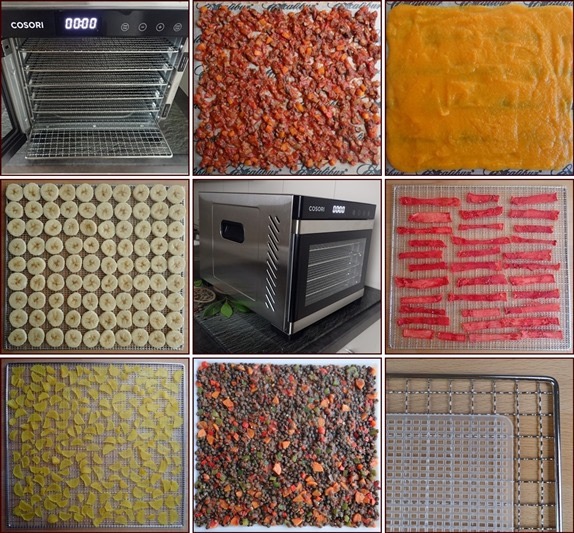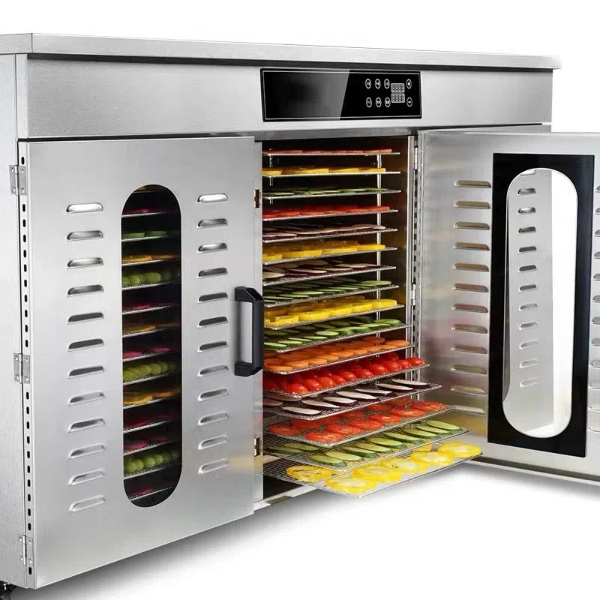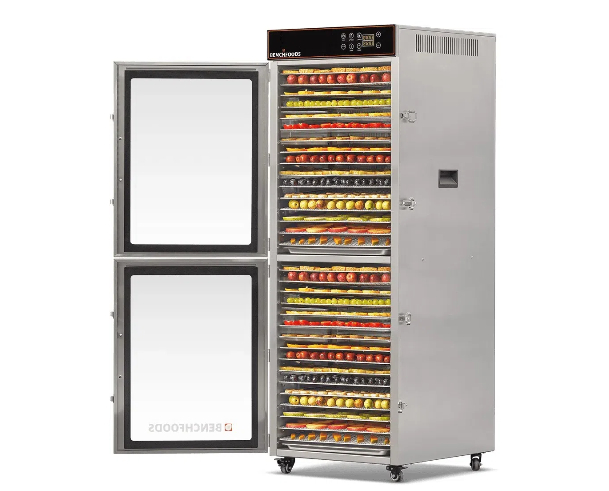
Content Menu
● 1. Understanding Cabinet Type Dehydrators
● 2. Key Factors to Consider
● 3. Types of Food Dehydrators
● 4. Advantages of Cabinet Type Dehydrators
● 5. Styles
● 6. Additional Features to Consider
● 7. Brand Recommendations
● 8. Practical Tips for Using Your Cabinet Type Dehydrator
● Conclusion
● FAQ
>> 1. What is the ideal temperature range for dehydrating different types of food?
>> 2. How important is the wattage of a food dehydrator?
>> 3. What are the benefits of a rear-mounted fan in a food dehydrator?
>> 4. Should I consider a food dehydrator with a timer and auto shut-off?
>> 5. What should I look for in terms of the construction and controls of a food dehydrator?
● Citations:
Choosing the right cabinet-type dehydrator involves several considerations to ensure it meets your specific needs. Whether you're a small-scale food producer, a health-conscious home chef, or a manufacturer looking to expand your capabilities, selecting the appropriate dehydrator is crucial. This comprehensive guide will walk you through the essential factors to consider, helping you make an informed decision and get the most out of your dehydration process.
1. Understanding Cabinet Type Dehydrators
Cabinet dehydrators, also known as vertical airflow dehydrators or box dehydrators, are characterized by their enclosed, cabinet-like design. Inside, multiple trays are arranged, and the heating element and fan are strategically placed to circulate warm air evenly throughout the chamber. Typically, the heating element and fan are located at the back of the unit in horizontal airflow dehydrators or at the bottom or top in vertical airflow dehydrators. This design is a significant advantage, as it promotes consistent drying across all trays, eliminating the need for manual tray rotation – a time-consuming and sometimes messy task required by other dehydrator types. This feature alone makes cabinet dryers an attractive option for users seeking efficiency and ease of use.
The defining characteristic of cabinet dryers is their ability to maintain a stable and controlled environment. The enclosed design minimizes fluctuations in temperature and humidity, which is particularly important when dehydrating delicate or sensitive foods. This level of control is often challenging to achieve with open-tray or stackable dehydrators, where external factors can easily disrupt the drying process.

2. Key Factors to Consider
Before diving into specific models, it's essential to assess your specific needs and requirements. Consider the following factors to narrow down your options and choose a dehydrator that aligns with your goals:
-Capacity: Your production volume is a primary consideration. Cabinet dryers are well-suited for a range of production scales, from small batches to larger outputs. Depending on the model, they can handle volumes ranging from approximately 30 kg to over 1 ton per shift. For smaller operations, a compact cabinet dehydrator with a handful of trays may suffice. However, if you anticipate higher volumes, opt for a larger model with more trays and a greater overall capacity. The ability to expand the capacity, if possible, should also be considered for future growth.
-Airflow: The airflow system is the heart of any dehydrator. Vertical airflow dehydrators are known for their consistent drying performance. With the fan and heating element typically located at the rear or bottom/top of the unit, warm air is circulated vertically and evenly across all trays. This ensures that each tray receives the same level of heat and airflow, resulting in uniform dehydration. Look for models that boast a robust fan and a well-designed airflow system to maximize efficiency and minimize the risk of uneven drying.
-Temperature Range: Different foods have different drying temperature requirements. For example, herbs and delicate vegetables require lower temperatures to preserve their flavor and nutrients, while meats and fruits may need higher temperatures to ensure proper preservation. An adjustable thermostat is, therefore, a must-have feature. Ensure that the dehydrator offers a wide temperature range, typically between 105°F to 165°F (40°C to 74°C), to accommodate various food types. Precise temperature control is essential for achieving optimal results and preventing spoilage.
-Wattage: The wattage of a dehydrator indicates its power consumption and, to some extent, its drying speed. A higher wattage generally equates to greater efficiency and faster drying times. While it's important to balance wattage with energy efficiency, aim for a model with 400 watts or more to ensure sufficient drying power.
-Timer and Auto Shut-Off: Convenience and safety are paramount, especially when dealing with extended drying times. A built-in timer allows you to set the desired drying time and forget about it. The auto shut-off feature automatically turns off the dehydrator once the set time has elapsed, preventing over-drying and potential fire hazards. These features are particularly useful if you plan to dehydrate food overnight or while you're away from home.
-Material: The material used for the trays and the dehydrator housing can impact its durability, hygiene, and overall performance. Stainless steel trays are often preferred for their durability, resistance to corrosion, and easy cleaning. They also offer a sleek and professional appearance. BPA-free plastic trays are another common option, particularly in vertical food dehydrators, due to their versatility and affordability. Ensure that the plastic is food-grade and heat-resistant to prevent leaching of harmful chemicals into your food.
-Controls: The controls should be intuitive and easy to use, even for beginners. Look for models with clear and well-labeled buttons or a user-friendly digital interface. Some dehydrators offer advanced features such as pre-set drying programs for specific food types, allowing you to achieve consistent results with minimal effort.
3. Types of Food Dehydrators
The market offers a variety of food dehydrators, each with its own set of features and benefits. Understanding the different types can help you narrow down your choices and select the one that best suits your needs.
-Stackable Tray Dehydrators: These are typically the most compact and affordable type of dehydrator. They feature stackable trays that sit on top of each other, with the heating element and fan usually located at the base. Stackable tray dehydrators are suitable for small kitchens and occasional use. However, they often require manual tray rotation to ensure even drying, as the trays closest to the heat source tend to dry faster.
-Vertical Airflow Dehydrators (Cabinet Type): As previously discussed, these dehydrators offer a larger capacity, more consistent drying, and greater convenience compared to stackable models. They are ideal for frequent use or large-batch dehydration. The vertical airflow system ensures that all trays receive the same level of heat and airflow, eliminating the need for tray rotation and delivering uniform results.
-Tunnel or Rotary Hot Air Dryers: These are industrial-grade dehydrators designed for large-scale commercial operations. They utilize a tunnel or rotary drum to circulate hot air around the food, providing efficient and uniform drying. Tunnel or rotary hot air dryers are typically used for processing large quantities of fruits, vegetables, and other food products.
-Commercial Food Dehydrators: Designed for businesses needing higher production volumes, they provide more uniform drying, especially for sensitive products.

4. Advantages of Cabinet Type Dehydrators
Cabinet type dehydrators offer a number of advantages over other types of dehydrators, making them a popular choice for both home and commercial use.
-Even Drying: The vertical airflow system ensures consistent drying across all trays, resulting in uniformly dehydrated food.
-Larger Capacity: Cabinet food dehydrators often provide more drying space compared to stackable models, allowing you to dehydrate larger quantities of food at once.
-No Tray Rotation: The even airflow eliminates the need to manually rotate trays during the drying process, saving you time and effort.
-Versatility: Commercial cabinet dehydrators are suitable for dehydrating a wide variety of foods, from fruits and vegetables to meats, herbs, and even flowers. The consistent temperature and airflow allow you to dehydrate different food types with predictable results.
5. Styles
The two main styles of food dehydrators, horizontal and vertical airflow, have distinct characteristics that cater to different preferences and needs:
-Horizontal Airflow: The heating element and fan are positioned on the side or back of the unit. This design has several advantages: it reduces the mixing of flavors between different foods being dehydrated simultaneously, provides equal heat exposure to all trays, and prevents liquids from dripping onto the heating element, which can cause damage or create safety hazards. Horizontal airflow dehydrators are generally considered to be more efficient and produce more consistent results than vertical airflow models.
-Vertical Airflow: The heating element and fan are positioned at the bottom or top of the unit. While these models are often more compact and affordable, they may not provide as even drying as horizontal airflow dehydrators. The trays closest to the heat source tend to dry faster, requiring manual tray rotation to ensure uniform results. Vertical airflow dehydrators can also be more challenging to clean, as food particles and liquids can easily fall onto the heating element.
6. Additional Features to Consider
Beyond the core features mentioned above, several other factors can influence your choice of a cabinet-type dehydrator:
-Digital Controls: Digital controls offer greater precision and convenience compared to analog controls. They allow you to set the temperature and drying time with accuracy, and some models even offer pre-set programs for different food types.
-Transparent Door: A transparent door allows you to monitor the drying process without opening the dehydrator, which can disrupt the temperature and humidity levels.
-Drip Tray: A removable drip tray at the bottom of the dehydrator catches any drips or spills, making cleaning easier.
-Noise Level: Some dehydrators can be quite noisy, which can be a concern if you plan to use it in a quiet environment. Look for models that are specifically designed to operate quietly.
-Warranty: A good warranty provides peace of mind and protects you against potential defects or malfunctions.
7. Brand Recommendations
Choosing a reputable brand can increase your chances of getting a high-quality, reliable dehydrator. Here are a few brands that are well-regarded in the industry:
-Excalibur: Excalibur is a highly recommended and trusted brand among dehydrator users. Their dehydrators are known for their durability, performance, and even drying capabilities. Excalibur offers a range of models to suit different needs and budgets.
-Nesco and Elite Gourmet: These brands offer more affordable options that still perform well. They are a good choice for budget-conscious consumers who don't want to sacrifice quality.
8. Practical Tips for Using Your Cabinet Type Dehydrator
Once you've chosen the right cabinet-type dehydrator, here are some practical tips to help you get the most out of it:
-Prepare Food Properly: Cut food into uniform slices or pieces to ensure even drying. Remove any seeds, pits, or cores.
-Pre-treat Food: Some foods, such as apples and bananas, benefit from pre-treatment to prevent browning. You can soak them in lemon juice or ascorbic acid solution.
-Load Trays Evenly: Spread food evenly on the trays, leaving some space for air circulation. Avoid overcrowding the trays.
-Monitor Drying Progress: Check the food regularly during the drying process. Adjust the temperature or drying time as needed.
-Store Dehydrated Food Properly: Once the food is completely dehydrated, store it in airtight containers in a cool, dark, and dry place.
Conclusion
Selecting the right cabinet type dehydrator requires careful consideration of your production needs, desired features, and budget. By understanding the key factors outlined in this guide, you can confidently choose a model that enhances your food processing capabilities and delivers consistent, high-quality results. From understanding airflow dynamics and temperature ranges to evaluating material quality and ease of use, each element plays a crucial role in the overall performance and longevity of your dehydrator. Remember to prioritize features that align with your specific needs and choose a reputable brand known for its reliability and customer support. Ultimately, the right cabinet type dehydrator will empower you to preserve food safely, create healthy snacks, and explore a world of culinary possibilities.

FAQ
1. What is the ideal temperature range for dehydrating different types of food?
An adjustable thermostat that allows you to set temperatures from 105°F to 165°F is important, as different foods require different drying temperatures. Delicate herbs and vegetables should be dried at lower temperatures (around 105°F to 115°F) to preserve their flavor and nutrients, while fruits and meats require higher temperatures (around 130°F to 165°F) to ensure proper dehydration and prevent spoilage.
2. How important is the wattage of a food dehydrator?
Higher wattage means more efficiency and faster drying times. Look for a model with 400 watts or more. A higher wattage dehydrator will heat up faster and maintain a consistent temperature, resulting in shorter drying times and more energy efficiency. However, it's important to balance wattage with energy consumption, as a very high wattage dehydrator may consume more electricity.
3. What are the benefits of a rear-mounted fan in a food dehydrator?
Models with a rear-mounted fan allow for more even air circulation across all the trays, resulting in more consistent drying. A rear-mounted fan ensures that warm air is distributed evenly throughout the dehydrator chamber, preventing hot spots and ensuring that all trays receive the same level of heat and airflow. This results in uniform dehydration and minimizes the need for tray rotation.
4. Should I consider a food dehydrator with a timer and auto shut-off?
Yes, these features allow you to leave the dehydrator unattended while it runs, providing convenience and safety. A timer allows you to set the desired drying time and forget about it, while the auto shut-off feature automatically turns off the dehydrator once the set time has elapsed. This prevents over-drying and potential fire hazards, making the dehydrator safer and more convenient to use.
5. What should I look for in terms of the construction and controls of a food dehydrator?
Look for simple controls and sturdy construction, as well as features that make loading and unloading the trays easy. The dehydrator should be made from durable, food-grade materials that are easy to clean. The controls should be intuitive and easy to use, even for beginners. The trays should be easy to load and unload, and the dehydrator should have a stable base to prevent tipping.
Citations:
[1] https://vrsupply.ca/blogs/buyers-guide/food-dehydrator-buyer-s-guide
[2] https://patents.google.com/patent/CN110207480A/zh
[3] https://aradmachineryco.com/article/Food-dehydrator-buying-guide
[4] https://patents.google.com/patent/CN1110593C/zh
[5] https://pleasanthillgrain.com/resources/dehydrators-buying-guide
[6] https://www.whirlpool.com.hk/media/wysiwyg/Downloads/WWPR64210_user_manual_program_chart_EN_CN.pdf
[7] https://www.thespruceeats.com/best-food-dehydrators-4077285
[8] https://shop.howlifeusa.com/zh/washing-machine/











